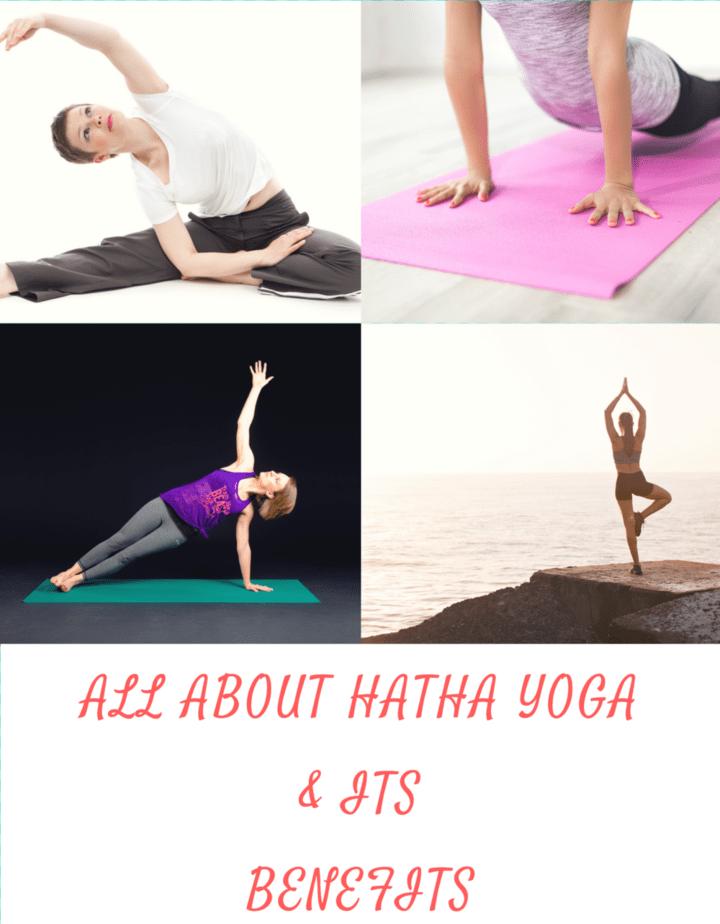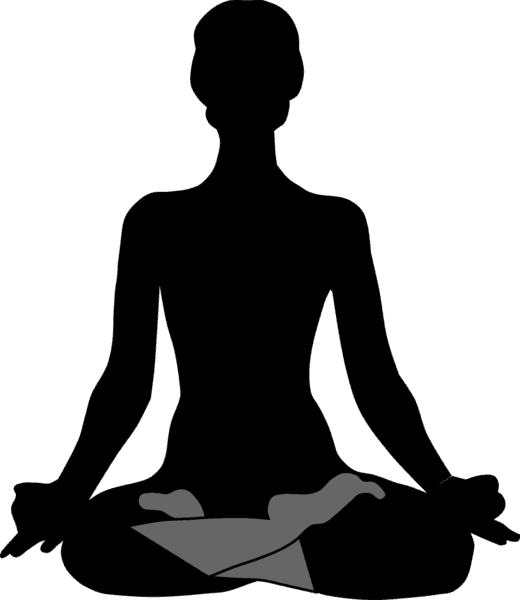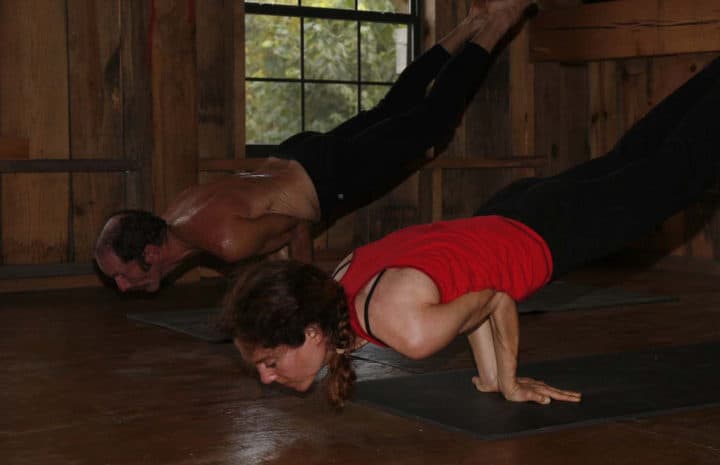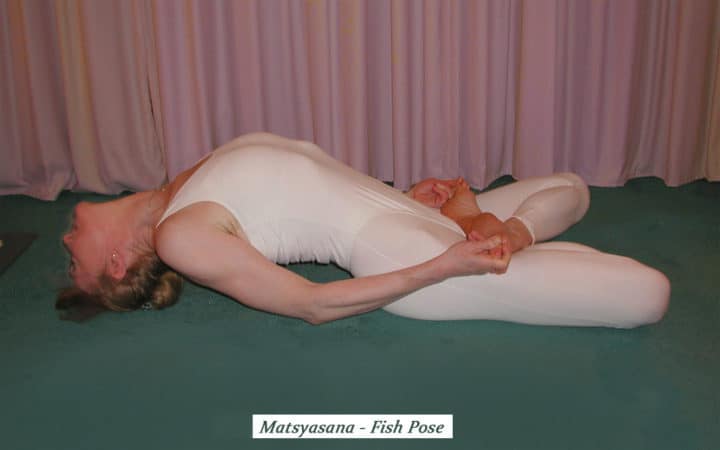Last updated on November 18th, 2021
Hatha Yoga teaches us to use the body as the bow, asana as the arrow, and the soul the target.
~B.K.S. Iyengar
B.K.S Iyengar was the founder of the style of yoga known as ‘Iyengar Yoga’, a form of Hatha yoga. He is considered one of the foremost yoga teachers in the world.

Before learning about Hatha yoga, give your minute to know about yoga, its origin, and its types !!
What is Yoga?
The word ‘Yoga’ comes from the Sanskrit word ‘Yuj’ which means ‘to add’, ‘to unite’, ‘to join’, and ‘to attach’. It focuses on bringing harmony between mind and body. It is also practised for spiritual growth.
Yoga is a group of physical, mental and spiritual disciplines. It is an extremely subtle science that first originated in ancient India. Its description is in Indian scriptures such as Rig-Veda, Upanishads and Bhagavad Gita.
Later, the great sage and yogi Patanjali compiled the Yoga Sutras. He organized knowledge about yoga from older traditions.
Yoga Sutras of Patanjali is a prominent collection of 196 Indian Sutras on the theory and practice of yoga. It describes 8 limbs of yoga called Ashtanga yoga :
- Yama
- Niyama
- Asana
- Pranayama
- Pratyahara
- Dharana
- Dhyana
- Samadhi
The different branches of yoga describe how to attain excellence physically, spiritually and mentally. For example – Raja yoga talks about how to unite with the supreme soul while Hatha yoga focuses mainly on bodily practices. It makes your body active, fit and free of diseases.
Similarly, other branches of yoga are for different purposes.
Types of Yoga
There are mainly 6 original branches of yoga :
- Raja Yoga
- Bhakti Yoga
- Jnana Yoga
- Karma Yoga
- Mantra Yoga
- Hatha Yoga
All modern yoga practices namely Power yoga, Hot yoga have evolved from all these only. Among these, the best-known type of yoga is Hatha yoga and Raja yoga.
Swami Vivekananda introduced yoga to the western world first. Besides him, there are other Indian gurus such as BKS Iyengar, owing to them, yoga got popularity in the west.
As a result that, the term like Power yoga and Hot yoga got birth. People in the west adjusted it with other fitness programs.
What is Hatha Yoga?
Hatha yoga is a holistic path that includes discipline, cleansing techniques. These techniques are shat kriyas, asanas, pranayama, mudras (gestures) and meditation.
Raja yoga is considered to be the most auspicious because it provides knowledge to unite the individual self to the supreme self. And Hatha yoga helps the person learn the Raja yoga fast.
Hatha Yoga Meaning
It refers to physical yoga postures.
Hatha refers to force as well as to stick fast, to hold closely or firmly.
Yoga refers to uniting, associating, attaching, and joining. It also means zeal, endeavour, focusing the mind on one point and feeling the energy.
Hatha yoga is balancing the body in a steady posture along with a steady mind. Contemplation and meditation are also parts of this branch of yoga.
In short, practising yoga would benefit your health by all means.
Origin of Hatha Yoga
The science of Hatha yoga is the greatest of all sciences for the physical and mental development of a man.
Lord Shiva first revealed it to her wife Goddess Parvati who later imparted it to Brahma. Brahma taught it to his children, the sages Narada, Sanaka, and Sanatkumara. They passed it on to Vasistha and others later on.
Yogi Svatmarama set down this knowledge in the book Hatha Yoga Pradeepika. After that, many scholars translated and practiced it.
Most forms of yoga in the west fall under the category of Hatha yoga. Hatha simply refers to the practice of physical yoga postures. Ashtanga, Vinyasa, Iyengar, and Power Yoga classes are all Hatha yoga.
Hatha practices are designed to soothe your body, mind, and spirit in preparation for meditation.
Purpose of Hatha Yoga
Hatha yoga serves two main purposes simultaneously. The first is physical and the second one is spiritual.
To put it another way, Hatha yoga would strengthen your physical health initially and give spiritual benefits eventually.
Spiritual Purpose
Hatha yoga talks about winning over these obstacles and hindrances to spiritual awareness. It imparts knowledge of the moral, mental, intellectual and spiritual development of a person.
Not to mention, our brain is the dustbin of many filthy emotions such as lust, anger, greed, infatuation, pride, and malice.
On the positive side, Hatha yoga is there to assist us. It cleanses the mind and body and makes them solid to practice Raja yoga better. Thus, Hatha yoga helps achieve our supreme goal to unite with God.
To sum up, Hatha yoga is a stepping stone to learning Raja yoga. Practices such as samadhi and mudras focus on this purpose.
Physical
Hatha yoga is a biochemical, psycho-physiological and psycho-spiritual science. Its main purpose is the physical development of the body and to make it free of diseases. Physical postures do wonders to achieve this goal.
In the western world, Hatha yoga mainly focuses on physical postures for fitness and healthy living.
Power yoga, Bikram yoga, Ashtanga yoga, Iyengar yoga stems from Hatha yoga. In the final analysis, Hatha yoga is the mother of all modern yogas.
Benefits of Hatha Yoga
The benefits of Hatha yoga are unbelievably amazing. If I mention them here, you may not seem to believe them first.
As I have said, it is not your fault. Actually, at present, our body and mind have become slave to worldly things in such a manner that the possibility of anything beyond the physical is beyond our understanding.
Well, it may seem to be an impossible thing for you at first. But when you get a chance to meet the experts with extraordinary traits, you are bound to believe this science.
Hatha yoga is about how to conquer worldly requirements of the body such as hunger, thirst, and sleep. It amazingly explains how to overcome the effects of heat and cold. It helps restore your health occasionally when you are exposed to seasonal flu, fever or any diseases. What’s more, it works as a panacea.
Its special benefits are :
- A Hatha yogi doesn’t need warm clothes in winters.
- It strengthens your immune system miraculously.
- Helps preserve your youth.
- Negates the effect of old age and provide longevity.
- You can recover from diseases without taking drugs.
- Skin remains glowing and hair are grey even at the age of a hundred.
- It provides perfect health and a strong and fit body.
- Keeps your spine supple and nerves healthy.
- It increases flexibility by increasing the elasticity of connective tissues.
- Works on the whole nervous system.
- It is a very good workout if you want to lose weight.
- Hatha yoga gives the siddhis.
- The old sages have attained marvellous powers by practising it.
- More countless benefits………
Amazing no? You can set your daily fitness routine like this: do some workout in your home gym, some cardio exercise on a treadmill and also add some hatha yoga to improve the standard of your life.
Science about Hatha Yoga
Though, Hatha yoga is itself a science proven by many yogis and ancient scholars through ages and doesn’t need a certificate about its benefits, yet, there are many scientific proofs available about the positive effects of Hatha yoga on health.
Hatha yoga improves physical health as well as mental health. It reduces anxiety, stress, depression and other mental disorders. It is good for people of every age group (1,2,3,4,5).
Guidelines and Practice
Prefer light and comfortable cotton clothes. It facilitates easy movement of the body. Use a mattress, yoga mat or folded blanket for the practice.
For Hatha yoga practice, some guidelines and practices are important to follow.
Books on Hatha yoga have mentioned them in detail. You should take care of your diet and cleaning. They are as follows :
Diet
- Your stomach should be empty or not full during practice.
- Consume a small amount of honey in lukewarm water if you feel weak during asanas.
- Do not instantly consume food just after yoga.
- There should be a gap of at least 20-30 minutes between practice and meal times.
- A strict diet is recommended usually a vegetarian diet.
- Avoid any food which is sharp, sour or excessively hot or cold.
- Avoid garlic and onion.
- Do not eat any food which is hard to digest.
- Leave oily food, mustard, liquor, fish, the flesh of animals, excess salt and acidity.
- Whole grain, Rice, milk, sugar, butter, milk, honey are good for a Hatha yogi.
- If you are over 30 years, two meals a day are sufficient. Exceptions are in case of illness or very high physical activity or labour.
Cleaning
It means cleanliness of not only surroundings but of body and mind also.
- The place where you chose to practice Hatha yoga, should be clean, quiet and fragrant.
- Noise pollution should not disturb you at all.
- Your body should be clean.
- Take shower and empty your bladder and bowels.
Breathing
- You must not hold your breath unless it is specially mentioned to do so.
- Always breathe through the nostrils unless instructed otherwise.
Precaution
- Do not practice it in any chronic disease, any kind of pain or cardiac problems.
- You better consult a physician or a yoga therapist before performing yogic practices.
- Never start Hatha yoga without consulting yoga experts.
- Women should not practice it during menstrual periods or pregnancy.
- There are some caution and guidelines for each practice of Hatha yoga which you must follow.
- For instance – you should not perform Cobra pose if you have a hernia and ulcers or have undergone abdominal surgery lately.
Mudra (Gesture)
Mudra means spiritual gesture. These gestures are used mostly in meditation or pranayama practice.
These are performed by using hands. By doing so, you direct the flow of energy within the body.
Therefore, when you practice these mudras, you stimulate different areas of the brain. It creates a specific energy circuit in the body.
In Ghrendra Samhita there are 25 main mudras.
In Hatha Yoga Pradeepika by Svatmarama, there are ten mudras namely :
1. Maha Mudra (Great Gesture)
Maha Mudra gives both physical and spiritual benefits.
- this gesture raises the consciousness to higher levels.
- improves the digestive system by curing the disorders of the stomach.
- it helps to attain good health.
2. Maha Bandha (The Great Lock)
Maha Bandha is categorized as a yogic gesture in both the classical texts Hatha Yoga Pradeepika and the Gheranda Samhita.
- it gives the combined benefits of 3 basic bandhas which are: Moola Bandha, Uddiyana Bandha, and Jalandhar Bandha.
- this gesture helps to channel pranic energy in a certain way.
- it works as an anti-ageing mechanism by rejuvenating the cells in the entire body.
3. Maha Bheda (The Great Piercing Attitude)
Maha Bheda Mudra is practised to pierce the seven chakras. It forms part of Hatha yoga as well as Kriya yoga practices.
- this mudra gives all the benefits of Maha Bandha.
- it increases the concentration of the mind.
- harness the energy at the three chakras.
- it prepares the mind for meditation.
4. Khechari (The Tongue Lock)
Khechari mudra is performed by rolling up the tongue to touch the soft palate. After practising initially this way, insert the tongue into the nasal cavity behind the palette.
- this gesture protects from disease, decay, and death.
- the immune system becomes very strong by its practice
- body becomes divine.
- it provides control over fainting, laziness, thirst, and hunger.
5. Uddiyana Bandha (The Abdominal Lock)
In this practice, the practitioner pulls the abdomen inwards after exhalation and holds the breath outside
Uddiyana Bandha should be practised before the meditation and after asanas and pranayama.
- this mudra gives the message to all the organs in the abdomen.
- it increases the digestive fire.
- removes stress, anxiety disorders.
- it tones the adrenal glands.
6. Mula Bandha (The Root Lock)
Mula Bandha is to stimulate the pelvic nerves, massages the entire pelvic region including the urinary, excretory and genital organs.
- this gesture relieves constipation.
- it helps relieve anal fissures, piles, and some ulcers.
7. Jalandhar Bandha (The Chin Lock)
- it activates the Vishuddhi Chakra.
- its description is in the yogic texts Hatha Yoga Pradeepika, Gheranda Samhita and the Siva Samhita.
8. Viparita Karani
Viparita – ‘inverted’
Karani – ‘doing’.
This asana is one of the simplest of the inverted asanas.
In Haṭha Yoga Pradeepika, it is listed as a mudra.
- it directs the energy or kundalini upwards within the body.
- The final pose for the mudra and the asana is the same.
- it is good for those suffering from hypothyroidism.
- this mudra has various health benefits especially for those suffering from piles and hydrocele.
9. Vajroli
Vajroli is derived from the Sanskrit word, ‘Vajra’. Vajra means thunderbolt and lightning.
- this mudra preserves sexual energy.
- it activates other chakras and awakens kundalini.
- redirects sexual energy up the spine to other chakras.
- it strengthens urinary muscles.
10. Shakti Mudra
You must have heard the meaning of the word ‘Shakti’ which refers to strength and power. It is another name of Goddess Durga who Herself is the source of all the strength of the universe. So, this mudra enhances your inner strength to bring stability in life.
- this is a hand gesture targeted to reduce your sleeping disorders.
- it improves and enhances your mental and physical well-being.
- this mudra calms the mind, body and pelvic area.
These are the ten mudras that annihilate old age and death. These mudras remove the diseases caused by indigestion, leprosy, consumption and other irregularities in the body. They require very hard practice.
Samadhi
Samadhi means liberation, the ultimate goal of yoga. This oneness of the self and the universe self, when all Samkalpas (personal desires) cease to exist, is called samadhi.
It is a meditative state where the mind is completely absorbed. Yogis attain this trance by the practice of dhyana (meditation). In samadhi, the mind becomes still.
Pranayama
Pranayama is a set of breathing exercises.
Prana– the force of life
Ayam– to control prana energy.
Pranayama consists of developing an awareness of your breathing.
In this practice, respiration is wilfully regulated on a functional or vital basis. Hence, it helps develop an awareness of the mind.
Bandhas and Mudras are the practices associated with Pranayama.
In the book Hatha Yoga Pradeepika, Yogi Svatmarama describes various types of pranayama. They have different effects on the body, mind, and spirit. Below are their names with objectives :
Surya Bhedna
Its objective is to increase vital energy in the body.
Nadi-Shodhana
- it focuses on purifying the Ida Nadi and Pingala Nadi.
- the main objective is to bring harmony between mental force and vital force.
Bhastrika
- it stimulates and fastens the blood circulation in the body.
- drains the gas from the body.
- this pranayama creates compression and decompression in the brain.
Ujjayi
- this is helpful in insomnia and tension
- it cures heart diseases.
Sitkari and Shitali
Sitkari is performed by drawing in the air through the mouth, keeping the tongue between the lips.
They both have the same effects.
- these mudras cool the body.
- they moisture the whole system.
Bhramari
Bhramari is derived from the word ‘Bhramara’ which means a black bee. During this practice, the sound produced resembles the buzzing of a black bee.
- this pranayama helps relieve stress.
- it helps alleviate anxiety, anger, and hyperactivity.
Kapalabhati
Kapala: skull
Bhati: shining, illuminating
It is a breathing process that involves short, rapid and forceful inhalation and exhalation.
- Kapalabhati dries up all the disorders from the excess of phlegm.
- it improves digestion and helps to lose weight.
- reduces eye tension.
- improves blood circulation.
- it strengthens the liver and kidneys.
- this pranayama makes you look younger & beautiful.
Note – You must not start the practice of pranayama after reading from somewhere. Practice it under the guidance of a guru. Otherwise, it may deteriorate your health.
Related,
Benefits of Hatha Yoga Poses
In Hatha yoga Pradeepika, Svatmarama described asanas first because they are the first step of Hatha yoga. They give steadiness and health. These poses remove the heaviness of the body and mind as well.
Lord Shiva taught 84 asanas. Among them, some popular Hatha yoga poses are much popular.
They help fight much physical malice like depression, obesity, and other organ problems. These poses yield an abundance of benefits :
#1. Padmasana (Lotus Pose)

Padmasana or Lotus Position is a cross-legged sitting asana.
- it is a great exercise for joints because it increases flexibility.
- Lotus pose calms the brain and increases its attentiveness and awareness.
#2. Bhadrasana (Gracious Pose)
Bhadrasana, a Gracious Pose is good for activating the Mooladhara chakra.
- it strengthens the thighs, hips, and buttocks.
- this pose makes the muscles of your legs flexible.
- it is an excellent posture for meditation.
#3. Virasana (The Hero Pose)
It is a meditative pose also called the Hero pose.
- Virasana stretches the hips, thighs, knees, ankles, and feet.
- this pose stimulates blood circulation and relieves tired legs.
- it is good for digestion.
- Strengthening foot arches, relieving flat feet.
- it helps relieve gas.
#4. Mayurasana (Peacock Pose)

This is the pose when you have to assume a peacock-like posture.
- Peacock pose detoxifies the body.
- it destroys all diseases.
- this pose stimulates blood circulation in the abdominal area.
- also stimulates the stomach’s fire.
- it kills tumours and fevers.
#5. Sirshasana (Headstand Pose)
It is an inverted pose. In this pose, the body is completely inverted and held upright. Forearms support the body while the crown of the head rests lightly on the floor.
- this pose helps relieve stress and increases focus
- it improves blood flow to the eyes, head, and scalp.
#6. Siddhasana (Accomplished Pose)
This pose is to open the door of liberation. Therefore, it is known as the best pose.
- it removes impurities from the body and mind.
- Siddhasana is a practice to get enlightenment.
#7. Matasyasana (Fish Pose)

In this pose, the body resembles a fish.
- fish pose acts as a weapon to destroy a multitude of deadly diseases.
- its regular practice awakens the kundalini.
- it relieves respiratory problems.
#8. Shavasana (Corpse Pose)
In this pose, the body resembles a corpse. You have to imitate like a corpse free from all stress.
- it removes fatigue
- this pose gives rest to the mind and body.
- it is performed when the body is exhausted after the practice of other asanas.
Also read,
- Can You Boost Metabolism & Lose Weight Doing Yoga? Let’s find Out
- 7 Effective Yoga Poses To Improve Mental Health
- How Yoga & Other Exercise Increase Your Immunity
Best Yoga accessories for a smooth yoga practice
Additional Resources for Hatha Yoga
Online Classes
- “Online Hatha Yoga Classes” by Yoga International
- “Hatha Yoga Videos” by Yoga Download
- “Best Hatha Yoga Podcasts” from famous yogis
- “Hatha Yoga Sequences + Advice” by Yoga Journal
- “Yoga Land” hosted by Andrea Ferretti
- “Hatha Yoga for Beginners: Better Balance” hosted by Melissa Krieger
References
- Sadhguru. (2015). Hatha Yoga Guide: Science, Benefits, and Insights – isha.sadhguru.org/in/en/wisdom/article/hatha-yoga-benefits
- Yogacharya Vishwas Mandlik. (n.d.). Hatha Yoga – yogapoint.com/hathyoga/hathyoga.aspx
- Nina Markel, (2010). HATHA YOGA: Benefits and Principles for a More Meaningful Practice. DOI: 10.1249/FIT.0b013e3181ed5af2
- Effects of a 12-Week Hatha Yoga Intervention on Cardio-respiratory Endurance, Muscular Strength and Endurance, and Flexibility in Hong Kong Chinese Adults: A Controlled Clinical Trial. (2015). ncbi.nlm.nih.gov/pmc/articles/PMC4475706/
- Articles on Hatha Yoga (n.d.) – Yoga Basics
- The Effects of Bikram Yoga on Health: Critical Review and Clinical Trial Recommendations. (2015)- ncbi.nlm.nih.gov/pmc/articles/PMC4609431/
Enjoyed the article? Share with someone you care about!
I really like this article. So helpful with all the images and the basic descriptions that invite participation without too much thinking
Glad, you found it useful:)
I am keen to learn yoga and make it a way of life. Your comprehensive post on Hatha Yoga has given me some inspiration. Thanks for the nudge!
You are welcome:)
Really It’s a very good article I am also the site owner Impressed by you